The old Freshwater Store. Photos courtesy Gerald Coeur, via the Humboldt Historian.
The Alexander Coeur family first came to Humboldt in the 1880s, and started the Freshwater Store in 1894. Harold Coeur, a second-generation son, served in World War I, and third-generation son Gerald served in World War II. All three generations operated the Freshwater Store, from 1894 to 1967. This is a history of the Coeur family, their military service, and their service to the community through the Freshwater Store.
Born in France in 1854, Alexander Coeur later immigrated to Nova Scotia, where he met and married Nellie Harrigan. The newly married couple arrived in Humboldt County in 1880. Alexander Coeur obtained work as a mule train skinner and a horsewagon deliveryman with the Alexander Brizard Company, transporting domestic goods and merchandise from A. Brizard store headquarters in Arcata to the various Brizard stores located to the east in the gold and silver mining communities.
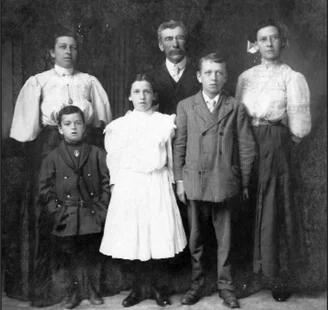
The Alexander Coeur family. Back row, from left: Nellie and Alexander Coeur and daughter Marie. Front row, from left: Ernest, Lena, and Harold (Gerald Coeur’s father). 1908.
The Brizard Company then appointed Alexander Coeur as Brizard store manager at New River (Old Denny) in Trinity County, where Coeur also became postmaster. From 1883 to 1896, Alexander Coeur was general manager at three separate Brizard stores located on the New River: at Francis; at Coeur (named for Alexander Coeur); and White Rock. By the 1890s, Alexander Coeur was ready to go into business for himself, and in 1894 he and Nellie Coeur purchased the Freshwater Store from the McGeorge Family. (Daughter Miss Edith McGeorge was an English teacher and vice principal at Eureka High School for thirty-plus years until 1936.)
The Freshwater Store was located at present day Freshwater, seven miles east of Eureka on the Kneeland/Freshwater Road with Freshwater Creek nearby. The Freshwater Store served a large area surrounded by Excelsior Lumber Company and Pacific Lumber Company timberlands. Travel to the Coeur Freshwater store was by train, mule, and horse and wagon.
According to an 1892 memoir by Hazel Mullin (spouse of Earl Mullin) on file at the Humboldt County Historical Society, the community of Freshwater had seven saloons during these years. She writes: “The white building next door was another saloon; there were seven in town.”
Alexander and Nellie Coeur had four children: daughter Marie (Lambert); son Harold; daughter Lena (Bowers); and son Ernest.
Harold Coeur, born in 1895, served in the U. S. Army during WWI, from 1917-1918, guarding for the allies the port of Vladivostok, an open seaport in Siberia, Russia on the Sea of Japan.
Upon his military discharge in 1919, Harold returned to Humboldt County and married Helen French of Eureka. Helen’s father, William (Bill) French, was a City of Eureka police officer, serving as traffic officer in the 1920s and 30s.
Harold and Helen Coeur took over the operation of Freshwater Store in 1920. Alexander Coeur died the following year.
Harold and Helen French Coeur had two children: Gerald A. Coeur and Virginia Coeur. Daughter Virginia married Francis Cook of Petrolia and settled on the Cook Ranch, where she raised three sons.
Gerald “Gerry” Coeur, born 1921, attended Garfield Grammar School in Freshwater, and then graduated from Eureka High School in 1940. As a Eureka High Logger Gerry lettered in four sports: football, basketball, baseball and track. In track he was Humboldt County track meet champion in 1939 and ‘40 in the one-quarter-mile run and second in the one- half-mile run. In football, as a sophomore halfback in 1937, he was a reserve behind the great Don Durdan and Len Longholm as the Loggers won the Northern California Championship by defeating San Jose 14-7. He was starting halfback in fall ‘38 and ‘39. In basketball, Gerry was a starting guard for two years. In baseball, he was a pitcher and outfielder for coach Les Mooneyham.
Eureka High football players, 1939. From Left: Gerald Coeur, HB; Bill Prentice, FB; Bill Ingram, HB; Gilbert Matsen, QB.
Gerry entered Humboldt State College in the fall of 1940 as a communications major. His academic goal was to become a radio announcer. In his sophomore year at HSC the events at Pearl Harbor on December 7, 1941 drew America into World War II. In January 1942, Gerry hitchhiked to San Francisco with the intent to become a pilot in the Army Air Corps. At the Ferry Building on Market Street, however, the Army line was long. While waiting in the Army line, Gerry noticed a shorter line with a large sign “Fly Navy.”
Soon he was in the Navy line, then he was taking physical and mental tests. He passed and was advised: “We will contact you.” He returned to Humboldt and in February 1942 the contact came. Gerry traveled by railroad and bus to Bishop, California for the first of several flight-training programs. He completed ground school with mechanics of flying and transferred to the preflight course at St. Mary’s Moraga Campus for three months (no flying).
At Livermore he underwent eighty hours of primary flight training in a two-seat open cockpit Boeing Stearman. His flight instructor was Lt. James Cady of Humboldt County. Cady’s father had been tender of the Trinidad Lighthouse. Cady was an athlete at HSC and later coached and taught at Arcata High School.
Gerry was sent to Cuddihy Field at Corpus Christi, Texas, for flight school, including night flying and formation flying. At Kingsville, Texas he received advanced training in shooting flying targets, dive- bombing, and navigation. He was commissioned an Ensign U. S. Naval Aviator and was assigned to OpaLocka, Florida Naval Station for Navy fleet training in a Brewster Buffalo. Considerable time was spent on field carrier landings. From Opa-Locka he was sent to Chicago to make his first carrier landings on Lake Michigan. The Navy had two converted ferries, the Sable and the Wolverine. All Navy pilots headed for sea duty would make six carrier landings on one of these vessels.
Gerald Coeur, second from left, with other members of the Sundowners squadron, circa 1943.
After a short leave home to Freshwater,
Gerry was assigned to San Diego Naval Air Station. In
July 1943 he volunteered to go to Alameda to join the
VF II “Sundowners” Fighter Squadron that had just
returned from the Guadalcanal Campaign. Here he
flew the newest and hottest Navy fighter — the Grumman Hellcat. The Grumman Hellcat had six 50-caliber
machine guns in the wings, eight five-inch rockets under the wings, and could carry up to a one-thousand-
pound bomb.
In Alameda, Gerry was close enough to fly home on his days off. “We had a good skipper,” recalls Gerry, “and we could take a plane on a 300-mile radius. At that time our local airport in McKinleyville was a small naval air station under Alameda command, so I could fly home.” On his way to the McKinleyville airfield, Gerry would announce his arrival as he flew over Freshwater by doing a loop and a roll over his hometown. “If the Navy had seen that,” recalls Gerry, “I would have been grounded and put on the end of a paintbrush!”
Gerry’s fighter squadron consisted of forty-five pilots and was joined by thirty-five dive-bomber pilots and thirty torpedo-bombing pilots. The three squadrons shipped to Hawaii and met the newly constructed aircraft carrier USS Hornet (CV-12) at Hollandia, New Guinea. Their ship had been named in honor of the previous Hornet (CV-8), which had been sunk at the Battle of Guadalcanal in the fall of 1942.
The Hornet moved to the Philippine Islands invasion supporting General Douglas MacArthur. Gerry’s fighter pilot squadron supported the invasions of Okinawa, Leyte Gulf, Manila Bay, Luzon, Lingayen Gulf, and Mindanao. They also flew strikes into mainland China and Indo-China.
As a pilot of the Grumman Hellcat, Gerry Coeur recalls that the Grumman plane had better armament and pilot protection than the Japanese Zero, made by Mitsubishi, when engaged in combat. He successfully shot down several Japanese Zeros and supported US ground troops on island invasions.
In January 1945 the USS Hornet, under the command of the third fleet commander, Admiral William “Bull” Halsey, moved to the South China Sea looking for Japanese shipping and hiding along the Indo-China coast. Gerry recalls that he and his air group sank five Japanese oil tankers, one destroyer, and one destroyer escort near Cam Ranh Bay on the Indo-China coast. Gerry Coeur, as a Lieutenant Junior Grade, was discharged from the Navy in December 1945.
Following the war, Gerry returned to Humboldt State College, where he graduated in 1948 with a degree in communications. From 1948-1952 he was a radio announcer and newscaster at KIEM radio, Sixth and E Streets, Eureka.
The Freshwater Store and Coeur family residence, circa 1924.
Then in 1952, Gerry became the third generation Coeur to own and operate the Freshwater Store. Of course, as the son of a family grocer, he had worked in the store before, but not with great success. As Gerry recalls:
When I was high school age I used to work for my Dad some. I was a delivery boy. My dad had a pickup for delivering groceries to ranches around Freshwater. Well, I had trouble with those pickups. I wrecked one, then another one. I was demoted to stocking the shelves. My dad took a pretty dim view of the whole thing.
But those problems were behind him, and Gerry successfully ran the store until 1967, when he sold the Freshwater Store. The longtime Coeur family institution had finally come to an end. The store building, now closed, still stands next to the Garfield School on Freshwater Road.
Gerry became a licensed stockbroker in Eureka in 1965, and retired from Lehman Brothers in 1988. Gerry and wife Dorothy (Rezzonico) had three children: Connie Lee; Jeff; and Marsha Coeur. Dottie died in 1988 after a successful career at College of the Redwoods. Gerry and his second wife, Georgann (Lenz), now live adjacent to the Baywood Golf Course at Bayside, where they enjoy community activities and playing golf.
The Coeur family operated the Freshwater Store for seventy-three years — a small enterprise, but in longevity second only to the famous A. Brizard Company as a “family grocer.” Through the Coeurs’ three-generation service as storekeepers, athletes, and soldiers, they have left a legacy. The Coeur family has earned our salute.
###
Ed. note from 2024: A year after this article was published, Gerry Coeur died at age 93. The Freshwater Store building is still there. It looks to be in pretty nice shape.
###
The story above is from the Spring 2014 issue of the Humboldt Historian, a journal of the Humboldt County Historical Society. It is reprinted here with permission. The Humboldt County Historical Society is a nonprofit organization devoted to archiving, preserving and sharing Humboldt County’s rich history. You can become a member and receive a year’s worth of new issues of The Humboldt Historian at this link.
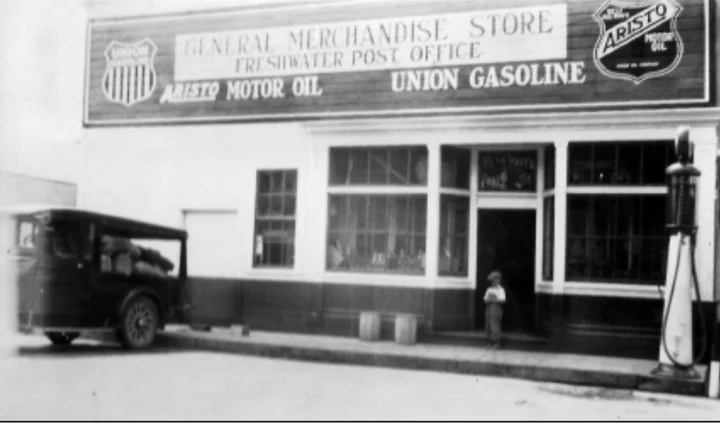

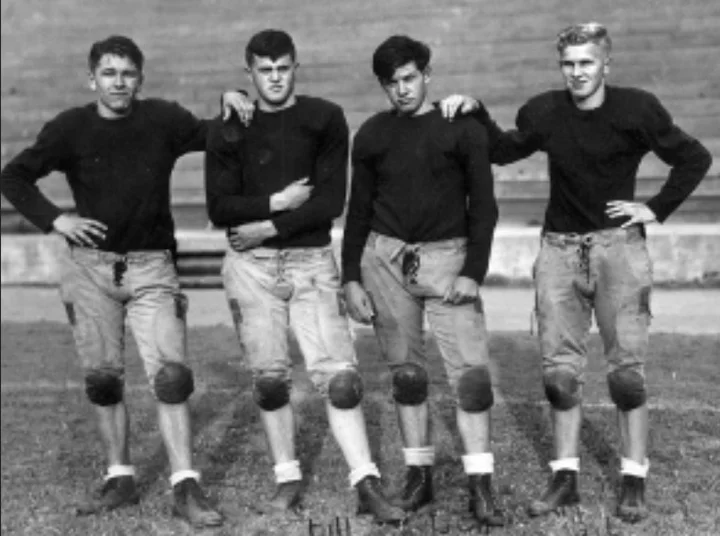
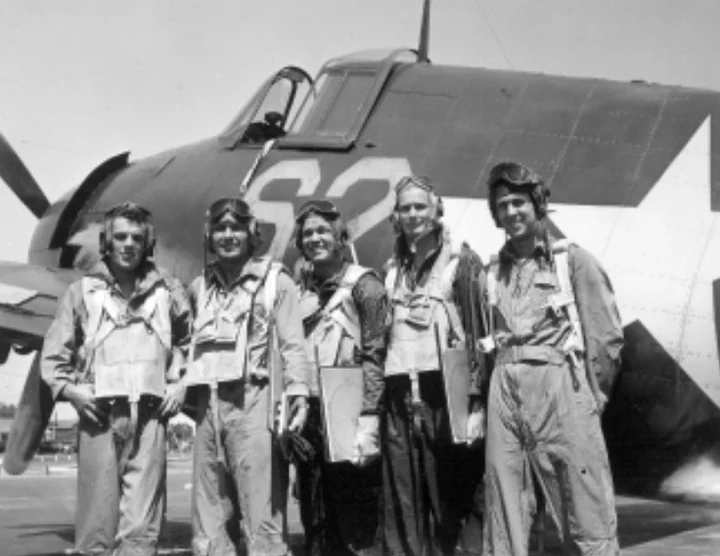
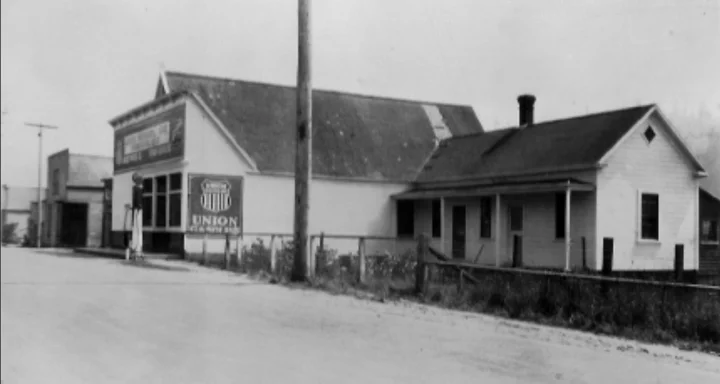
CLICK TO MANAGE